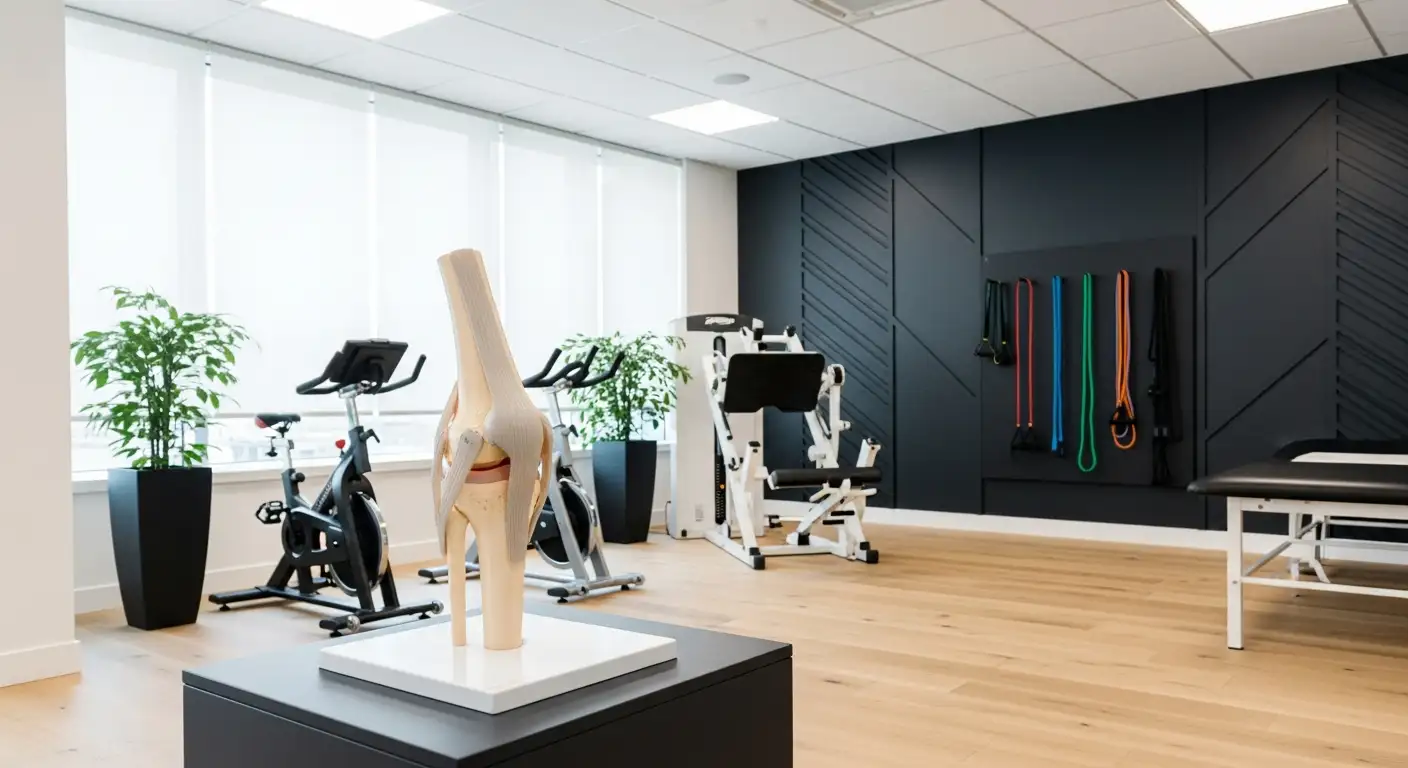Understanding Arthroscopic Knee Surgery
When discussing the success of arthroscopic knee surgery, it's vital to understand what the procedure entails, and what conditions it's commonly used to treat.
The Basics of Arthroscopic Surgery
Arthroscopic knee surgery is a minimally invasive procedure that allows surgeons to examine, diagnose, and treat problems inside the knee joint. By making small incisions around the knee, a surgeon can insert an arthroscope—a small camera instrument—into the joint. This technology provides a clear view of the inner knee, enabling the surgeon to address various issues without the need for a large incision, which may lead to a quicker recovery and less post-operative pain.

The surgery's general safety combined with a low risk of complications results in a generally high success rate for patients. However, results can vary based on factors such as the patient's age, health status, the type of injury, and the surgeon's skill level.
Common Conditions Treated
Arthroscopic knee surgery is often used to treat a range of knee conditions. One of the most common conditions treated using this procedure is arthritis—specifically, osteoarthritis of the knee. This degenerative condition, often seen in older adults, involves the deterioration of the cartilage that cushions the knee joint. Arthroscopic surgery can be used to remove loose pieces of cartilage or bone causing pain and inflammation.
Another common condition treated with knee arthroscopy is a meniscal tear. The meniscus is a piece of cartilage that provides a cushion between your femur (thigh bone) and tibia (shin bone). Tears in the meniscus can cause pain, swelling, and problems with knee function.
The success rate of arthroscopic knee surgery for these conditions is generally high, with a typical success rate around 95%. Factors influencing success include the severity of the condition and the age of the patient.
Understanding these key aspects of arthroscopic knee surgery can provide a solid foundation for discussing its success rate, as well as a comparison of its efficacy against other treatment options such as exercise therapy.
Success Rates of Arthroscopic Knee Surgery
Understanding the success rate of arthroscopic knee surgery is crucial for patients considering this procedure. Here, we delve into the overall success rates and the factors influencing these outcomes.
Overall Success Rates
When asking "how successful is arthroscopic knee surgery?", it's essential to note that success rates have shown a general increase over time, with recent figures indicating an overall success rate of around 85% Jaipur Joints. This improvement is largely attributed to advancements in surgical techniques, better equipment, and more experienced surgeons.
Figures courtesy Jaipur Joints
Factor Influencing Success Rates
While the success rate of knee arthroscopy surgery is generally high, not all patients experience positive outcomes. Results can vary depending on factors like the patient's age, health status, type of injury, and the surgeon's skill level Grant Chirocare.
In particular, age plays a significant role, with success rates varying based on patient age. The success rate for patients over 50 is approximately 71%, while it is around 87% for those under 50, primarily due to differences in knee joint cartilage development Jaipur Joints.
Figures courtesy Jaipur Joints
It's important for patients to discuss these factors with their doctors to understand their chances of success with arthroscopic knee surgery. This will help guide their decision-making process and manage their expectations.
Comparing Arthroscopic Surgery and Exercise Therapy
When considering treatment options for knee conditions, two common options are arthroscopic surgery and exercise therapy. The success of these treatments can be evaluated in terms of their efficacy in reducing pain and improving function.
Efficacy in Pain Reduction
Arthroscopic surgery has been traditionally viewed as a more effective option for treating degenerative knee conditions. However, recent studies have challenged this perception. For instance, a systematic review identified high-certainty evidence indicating that knee arthroscopy results in a very small reduction in pain up to 3 months and very small or no pain reduction up to 2 years compared with conservative management [3].
On the other hand, studies have shown that exercise therapy can be just as effective in reducing pain. In fact, patients who underwent physical therapy alone experienced similar improvements in pain after 6 to 12 months compared to those who had surgery [4].
Efficacy in Function Improvement
In terms of improving function, arthroscopic surgery offers a very small improvement in the short term and very small or no improved function up to 2 years compared with conservative management.
Conversely, non-surgical treatments like exercise therapy have been found to yield similar improvements in function compared to surgical interventions. This is supported by the study showing that patients who underwent physical therapy alone experienced similar improvements in function after 6 to 12 months as those who had surgery.
In conclusion, both arthroscopic surgery and exercise therapy can bring benefits in managing knee conditions. However, the comparative evidence suggests that exercise therapy might offer similar outcomes in terms of pain reduction and function improvement, making it a viable option to consider in certain cases.
Risks and Complications of Arthroscopic Knee Surgery
While arthroscopic knee surgery is a common procedure used to treat conditions like arthritis and meniscal tears with a typical success rate of around 95% (Jaipur Joints), it is not without risks. As with any surgical procedure, it's important to be aware of the potential complications that may arise.
Common Post-Operative Complications
Post-operative complications following knee arthroscopy include intense pain, significant swelling, and a heightened risk of infection. These complications can impact the recovery process and may require additional treatment.
According to a study published on NCBI, the absolute risk of one or more complications after knee arthroscopy was 1.1%. The relative risk for pyogenic arthritis after knee arthroscopy was 115, for venous thromboembolism was 6.8, and for other complications was 7.7.
Factors Increasing Risk of Complications
Several factors can increase the risk of complications after arthroscopic knee surgery. These include the severity of the condition being treated and the age of the patient.
The study on NCBI also noted that the odds ratio of any complication after knee arthroscopy vs. the reference cohort was 9.4, indicating a higher risk of complications in patients undergoing this procedure.
Another important factor to consider is the population attributable fraction for pyogenic arthritis due to knee arthroscopy, which stands at 5%. This essentially means that 5% of the pyogenic arthritis cases in the population could be attributed to knee arthroscopy.
Understanding these risks and complications of arthroscopic knee surgery can help patients and healthcare providers make informed decisions about the procedure. It's important to note that while complications can occur, they are relatively rare and most patients experience significant relief from their symptoms following surgery.
Long-Term Outcomes of Arthroscopic Knee Surgery
Evaluating the success of arthroscopic knee surgery involves assessing the long-term outcomes for patients, both in terms of mobility and pain management.
Patient Mobility Post-Operation
Studies have shown that patients' self-evaluated clinical symptoms improved considerably at 2, 6, and 8 years after arthroscopic knee surgery but deteriorated at 10 and 18 years post-operation. Knee mobility was greater post-arthroscopy but decreased from 6 to 18 years after surgery. Walking distance was significantly longer at 2, 6, and 8 years postoperatively than preoperatively.
Long-term studies have shown that after meniscectomy, there is an increased incidence of radiological signs of arthritis. Arthroscopic repair of torn menisci has therefore become the mainstay treatment method if repair is possible. The success of the repair can be influenced by several factors, including the type of tear and the individual's age. Most successful results have been reported in young individuals with stable knees and acute tears in the peripheral vascular zone of the meniscus. Additionally, medial meniscal repairs are less likely to heal than lateral meniscal repairs.
Pain Management Long-Term
On the aspect of pain management, the Visual Analog Scale (VAS) score for knee pain was significantly lower at 18 years post-operation than before the surgery.
However, studies have shown that arthroscopic knee surgery is not more effective than physical therapy for conditions like a torn meniscus or mild to moderate arthritis. In fact, those who underwent physical therapy alone experienced similar improvements in pain and function after 6 to 12 months compared to those who had surgery [4].
Recent studies have found no significant difference in the outcomes of arthroscopic knee surgery compared to more conservative treatments like physical therapy and medications. The surgery does not offer significant benefits in terms of pain relief, function improvement, or quality of life when compared to non-surgical interventions [4].
These findings highlight the importance of exploring all possible treatment options and weighing the potential benefits and risks before deciding on a course of action. It's crucial for patients and healthcare providers to have an open discussion about how successful arthroscopic knee surgery can be in each individual case, considering the patient's condition, needs, and long-term outcomes.
Costs and Economics of Arthroscopic Knee Surgery
When considering the economics of arthroscopic knee surgery, it's crucial to weigh the procedure's cost against its potential benefits. This includes examining the costs of non-surgical treatments, such as exercise therapy, and their efficacy compared to arthroscopic surgery.
Procedure Cost Analysis
In the United States, about 700,000 knee arthroscopies are performed annually, resulting in costs that exceed $3 billion a year [4]. This staggering figure points to the high financial impact of this surgical procedure. The cost of arthroscopic knee surgery can vary widely depending on several factors, including the complexity of the operation, the geographical location, and the type of facility where the procedure is performed.
Given the significant cost associated with arthroscopic knee surgery, it's crucial to assess whether this expense is justified by the procedure's success rate. This consideration is particularly relevant for patients with degenerative knee conditions, where alternative treatments may provide similar outcomes at a reduced cost.
Comparing Costs of Surgical and Non-Surgical Treatments
A study conducted to examine the effectiveness and costs of exercise therapy compared to arthroscopic surgery for degenerative knee found no significant difference in outcomes between the two [7]. The study suggests that arthroscopic surgery for degenerative knee may not be the most cost-effective option compared to exercise therapy.
The above table illustrates the comparison between the costs and effectiveness of arthroscopic surgery and exercise therapy. The study's findings suggest that the costs associated with arthroscopic surgery for degenerative knee conditions may not be justified, given that exercise therapy provides similar outcomes with less expense.
Based on the evidence from multiple studies, it is suggested that patients and clinicians should consider other treatment options before opting for knee arthroscopy for degenerative knee conditions. In light of these findings, it's essential for patients to have open discussions with their healthcare providers about the potential costs and benefits of different treatment options.
Arthroscopic Surgery versus Joint Replacement
For those seeking relief from joint pain, arthroscopic surgery and joint replacement provide two viable options. However, these treatments vary significantly in terms of healing times, success rates, and associated risks.
Comparing Healing Times
Arthroscopic joint replacement is noted for its relatively quicker healing times compared to traditional joint replacement procedures. Many patients regain a degree of joint movement after 4 to 6 weeks post-surgery, with close to full joint function achieved at about 8 weeks. Full or almost full healing is typically reached after undergoing physical therapy for about 3 months [8].
On the other hand, traditional joint replacement usually requires a longer hospital stay, ranging from 3 to 7 days compared to 1 to 5 days for arthroscopic joint replacement.
Comparing Success Rates and Risks
The success rate for arthroscopic joint replacement surgery stands impressively over 90 percent, indicating its effectiveness as a treatment option. It generally produces less pain, swelling, and discomfort than open joint procedures due to smaller incisions which create less exposure from the open skin. This contributes to its high success rate.
However, as with any surgical procedure, arthroscopic joint replacement does come with potential risks. These can include joint or wound infections, blood clots, or damage to the nerves or blood vessels near the joint, although these complications are very uncommon.
On the other hand, traditional joint replacement procedures may have varying success rates and risks attached, which should be discussed with a healthcare professional.
When considering arthroscopic surgery versus joint replacement, it's crucial to understand these key differences and consult with a healthcare provider to choose the best treatment option based on individual health conditions and lifestyle needs.
References
[1]: https://www.grantchirocare.com/weighing-arthroscopic-knee-surgery/
[2]: https://www.jaipurjoints.com/health-tips/what-is-the-success-rate-of-knee-arthroscopy-surgery/
[3]: https://www.ncbi.nlm.nih.gov/pmc/articles/PMC5541494/
[4]: https://www.health.harvard.edu/blog/knee-arthroscopy-should-this-common-knee-surgery-be-performed-less-often-2020042019507
[5]: https://www.ncbi.nlm.nih.gov/pmc/articles/PMC8532225/
[6]: https://www.ncbi.nlm.nih.gov/pmc/articles/PMC5484431/
[7]: https://pubmed.ncbi.nlm.nih.gov/24284049/
[8]: https://www.centerfororthosurgery.com/the-benefits-of-arthroscopic-joint-replacement/




